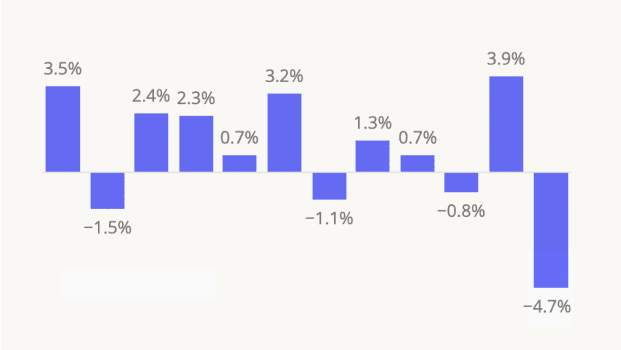As we wrap up Q1 2025, we’re already beginning to see a slow down in retail visitation by consumers. Despite general growth in retail visitation over the past few years, rapid price increases and changes in consumer behavior may finally have caught up to consumers across income levels. In this new unknown chapter of the retail industry, one thing is clear; high income consumers are critical for retailers to capture and retain in order to offset a drop-off in demand by other cohorts.
High income shoppers have long been the elusive target of retailers across a variety of price points. From Target to Neiman Marcus to specialty grocers, retailers have tried to enhance assortments, increase service offerings, and eliminate inconveniences for consumers who have the highest levels of disposable income. These factors only grew in importance as the retail industry navigated the pandemic and the subsequent consumer recovery – high income shoppers' price elasticity has bolstered the industry against rising inflation and price increases.
Share of High-Income Shoppers in Brick-and-Mortar Retail Declined Slightly Since the Pandemic
What’s fascinating, though, is that despite the buying power of high income consumers – they aren’t large contributors of retail visitation overall. According to our Placer 100 Dining and Retail Index, households with income greater than $200K accounted for 8.1% of overall visits in 2024, which is slightly lower than the share of visits from the same group in 2019 (8.2%). The share of visits from lower income households increased since the pandemic (32.9% of visits from households with a median income of $50K or less in 2024, compared to 32.7% in 2019), while the inverse is true for higher income shoppers.
The lower share of visits from high income households does align with the general trends we’ve observed across retail. Lower income shoppers, who have become more price conscious and constrained by rising costs, have increased their frequency of visits across multiple retail chains in order to derive the most value from their visits. Meanwhile, wealthier shoppers may have maintained or increased their online purchasing since the pandemic onset, which could have lessened their desire to shop in person.
With a smaller share of the wealthiest shoppers visiting retail locations, the fight for those consumer dollars is going to be even more competitive. Alternatively, for categories that are capturing even more visits from high income shoppers, the need to satisfy their needs and drive conversion is critical.
Walmart’s Success With Wealthier Cohorts
Retailers that have won over this group have tapped into the desire for value no matter the level of household income. Walmart executives recently shared that their largest growth in market share came from consumers with income over $100K. Placer’s foot traffic estimates also indicate that, indeed, traffic distribution for households with income over $75K increased in 2024 compared to 2022, with declines in the share of visits by lower income households.
Walmart attributed these changes to their increased premium service offerings, including its membership program and delivery services – but there could also be another element at play. As prices have gone up considerably since the pandemic, even wealthier shoppers don’t want to see their receipts rise on a daily or weekly basis. Price perception can spur changes in consumer behavior, and this can apply to any consumer, no matter their socioeconomic status. Walmart’s success with wealthier cohorts sends a message to others in the industry; just because a consumer can afford to pay higher prices, doesn’t mean they will.
Shifts in Luxury Retail Shoppers
On the other end of the retail spectrum, the luxury retail market is also facing new challenges in regards to their changing consumer base. As we discussed in our overview of the category in January, there has been a consolidation of visits favoring high income households. In reviewing the captured share of visits by household income for luxury apparel and accessories chains, the largest declines came from “aspirational shoppers,” or those who made less than $150K, who might shop for luxury brands less frequently or for a special purchase. With a smaller pool of potential shoppers to pull from, luxury brands can no longer rely on those outside their core base.
The higher concentration of ultra wealthy consumers forces luxury brands to once again center themselves around the in-store experience and competitive advantages. Brands are constantly vying for shoppers' attention, and luxury brands can take full advantage of their store fleets as a way to court consumers. Personal shoppers, services, and private appointments will all become more important for stores to make up for a potential loss in aspirational consumers.
According to Personalive’s window of insight into different socioeconomic consumer cohorts, Ultra Wealthy Families, defined as those with income higher than $200K, also frequent specialty grocery chains, high-end fitness clubs such as Lifetime Fitness and high-end home goods retailers like Restoration Hardware and West Elm. These retailers, similar to luxury apparel and accessories brands, cater directly to high income households, which provides both opportunities for growth and potential hurdles if these consumers change their spending habits.
High income shoppers are quickly becoming the most courted shopper cohort. As retailers look to innovate and open new locations, lucrative neighborhoods with more high-touch services might pave the way for growth. However, the industry, particularly retailers who service middle and low income families, cannot abandon their consumer base in their efforts. With consumers so intrinsically focused on value, even high income consumers can’t be relied on solely to sustain the retail industry.
For more data-driven insights, visit placer.ai




.png)
.png)

.png)
.png)

.jpg)












.svg)